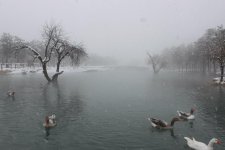| What's a Polar Vortex?: The Science Behind Arctic Outbreaks |
|
Share
By: By Jon Erdman
Published: January 6, 2014
One of the coldest Arctic outbreaks in two decades has plunged into country, bringing bitterly cold temperatures to the Midwest, South and East.
(
MORE: Cold Outbreak Forecast |
Live Winter Updates)
You may have heard us at weather.com and The Weather Channel mention the "polar vortex" during this outbreak. Let's delve into the Meteorology 101 about this.
One of several semi-permanent weather systems over the Earth, the polar vortex is an area of low pressure in the upper atmosphere that, on average in the Northern Hemisphere, typically has centers in two main areas: near
Canada's Baffin Island, and over
northeast Siberia.
The vortex is strongest in winter, thanks to an increased temperature contrast between the polar regions and the mid-latitudes, including the United States.
Animation of model upper-atmospheric pattern from Jan. 5-7, 2014 showing the displacement of the polar vortex. Deepest, coldest air is denoted by the colder colors.
Occasionally, the polar vortex can either be forced well south of its typical position, or a significant piece of the larger spin can break off and plunge south into the U.S.
In the case of this outbreak, a large piece of the vortex broke off and was forced well to the south over Ontario and the northern Great Lakes, as you can see in the animation at left (click the enlarge link for a bigger map).
Contributing to this southward buckling of the jet stream was a pronounced northward diversion of the polar jet stream over the eastern Pacific Ocean and West Coast of the U.S. To the east, or downstream of this northward diversion, or ridge of high pressure aloft, the polar vortex was forced southward.
Incidentally, this eastern Pacific ridge of high pressure aloft has been a persistent feature since December, helping to keep particularly the central U.S. stubbornly cold.
In essence, instead of cold, Canadian air grazing the northern tier of the U.S., then draining off into the north Atlantic Ocean, the heart of this Arctic air plunged south into the U.S.
When this pattern sets up, the central, southern and eastern U.S. can plunge into a deep freeze, with subzero cold over large swaths of the Midwest, interior Northeast and parts of New England. Freezing temperatures can plunge deep into Florida, including inland locations of South Florida.
Sometimes, a cold outbreak in the eastern U.S results even if the polar vortex in northeast Canada weakens.
Instead of a whirling dervish of low pressure aloft, high pressure aloft near Greenland, referred to as a Greenland block, effectively keeps cold, Canadian air from sweeping into the north Atlantic Ocean. Instead, it is forced south into the U.S., often plunging through Florida and sometimes parts of the northern Caribbean.
Depiction of the Greenland block pattern sometimes responsible for locking cold into the East and Midwest.
In this pattern, referred to by meteorologists as the negative phase of the North Atlantic oscillation (-NAO), persistent cold can lock in for a week, or more.
As is the case with this cold snap, there is no Greenland block, so the Arctic outbreak, while dangerously cold, will not persist long as the polar vortex returns home to near Baffin Island, Canada after its southern vacation later in the week.





















